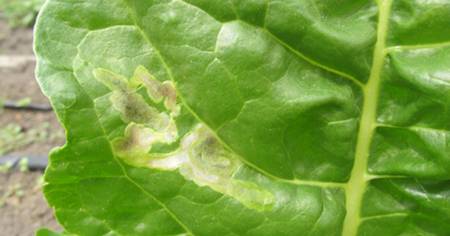Leaf Miners on Vegetables

If you have ever grown columbine, you probably recognize the insect damage on the leaf to the left. Leaf miners are the common name for the larval stage of several different types of insects, including moths, flies, beetles, and sawflies. The term "leaf miner" refers to the tunneling damage caused by insects between the layers of the leaf surface. Many insects feed their entire larval period within the leaf, and some will pupate inside it before emerging as adults. Our area usually has two generations, with the second generation overwintering as a pupa in the ground to emerge as adults in the spring.
In Kansas, the most common leaf-mining insect of vegetables is a type of fly, and the maggot is causing the damage to the leaf. In tomatoes and ornamental plants, the damage they cause usually doesn't harm the plant and only makes the leaf look bad. When it comes to plants, we eat the leaves; however, the damage isn't just superficial; it can make the leaf inedible. While the tunnels and the insects themselves are not a cause to stop eating the leaves, the feces left behind in the tunnels is. (I hope you weren't eating as you read this.)
Controlling leaf miners in vegetables should start with cultural control methods, including monitoring for the adults using yellow sticky traps, monitoring the leaves for larvae, and then removing the leaves if you can. Other cultural controls include using floating row covers over the plants as soon as you plant them to exclude the flies from laying eggs on the leaves, mixing your leafy vegetables with other crops as monocultures are prone to worse infestations, removing plants immediately after harvesting to prevent the pupa from entering the soil and working the soil in that area to kill any pupa in the ground. You should also avoid using excess nitrogen on leafy plants as this can cause leaf-miner infestations to worsen. Several natural predators can help keep the leaf miners in check if you encourage them to live in your garden.
If the infestation warrants it, you can use chemical control. The tricky part about treating leaf-mining insects is that they are protected by the leaf itself, so spraying the leaf's surface is insufficient to achieve control. You could use a systemic insecticide with ornamental plants to control the miners if the damage is severe. However, that is not an option for managing these insects in vegetable crops. To treat leaf miners, use products with the following active ingredients: Spinosad, permethrin, neem oil, or horticultural oils. Only use chemicals to treat when necessary as resistance to several insecticides has been found in areas with intensive vegetable gardening, and overuse of chemicals has also been found to make infestations worse by killing beneficial insects.

Have questions? Contact our office where our Horticulture Extension Agent will assist you with questions.
Phone: (316) 321-9660
Email: callae@ksu.edu